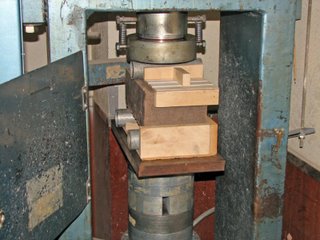
This is a picture of the testing press with a sample in the pressing area. The press looked like it was built by IBM in the hay day of punch cards, but it is still capable of applying 200000 pounds of force.

The first test we performed was the Modulus of Rupture. This involves "breaking" a sample over two fulcrums (pipes) spaced a specific distance apart and applying the force over a third pipe equidistant between the first two. This is easier to see than say, so the look to the right for a picture of the jig I built for the test.
The press applies a force to the top pipe at a rate of 500 psi/minute until the block "breaks." I put the last in quotes because I was expecting the block to break in two, but the press gauge is so sensitive that it is capable of stopping the press as soon as the block weakens and all you get is a small crack in the base of the block as shown in the following photo. Although the lack of breaking meant a lot less cleanup, it was a bit anticlimactic

After finishing all of the Modulus of Rupture tests, we proceeded on to the compression tests. I did not take any photos of this test, but it is done in the same press and without the pipes. Again the press loads at 500 psi/ minute until the block fails. In this case failure come in the form of small cracks appearing all around the block.
For the Modulus of Rupture, the code requires the blocks to hold at least 50 psi. The Native soil blocks held a little more than double this. The code requires the blocks to hold a minimum of 300 psi in compression. Our blocks held a little over three times this amount. It looks like the shop should be strong.
No comments:
Post a Comment